The use of procalcitonin (PCT) in the diagnosis of severe bacterial infections has been tested and proven by numerous international studies. We intend to evaluate how PCT is used in patient admission in various medical and surgical departments and the correlations between PCT and severity scores used for patients in critical state. The death rate correlated with the PCT values above 10 ng/ml and thrombocytopenia, APACHE II score and with a mean SOFA score of 8. For a cutoff value of 0.5 ng/ml in our study the sensitivity of the PCT was 86% with 91% specificity. Placing PCT in a key step in the schemes of the management of patients suspected of sepsis is an important factor in determining the strategy that should be followed, the antibacterial and immunological therapy and the treatment costs implication. Procalcitonin remains so far the best pro-inflammatory marker used in the management of patients with severe bacterial infections.
Keywords |
| Severe bacterial infections, Sepsis, Procalcitonin, C-reactive protein. |
Abbreviations |
| PLT: Platelets; CRP: C-reactive protein;
OR: Odds Ratio; ICU: Intensive Care Unit. |
Introduction |
| The use of procalcitonin (PCT) in the diagnosis of
severe bacterial infections has been tested and proven
by numerous international studies. In this study we
intend to evaluate how PCT is used in patient admission
in various medical and surgical departments and the
correlations between PCT and severity scores used for
patients in critical state. Based on this idea, we conducted
a prospective observational study, from January 2008 to
December 2013, in which we have enrolled all patients in
whom the PCT serum level has been determined. The study
was conducted in the Academic Emergency Hospital Sibiu,
Romania, where 406 patients were enrolled. We analyzed
the motivation for the PCT determination, the initial
diagnosis, the presumption of severe bacterial infection,
the PCT correlations with the presumptive diagnosis,
the values of other proinflammatory markers, and the
correlations of the studied markers and the evolution of
confirmed cases with the sepsis. |
Materials and Methods |
| The study focused on 406 patients who were
hospitalized between January 2008 and December 2013,
patients in whom the PCT value was determined at the time of admission or later during hospitalization. The PCT
level detection was decided in the absence of a protocol
for the use of this test in an effort to determine whether the
antibiotic therapy should be initiated and to differentiate
bacterial infections from other infectious or noninfectious
causes responsible for the clinical picture. The PCT levels
were determined using the immuno-chromatographic
assay for the semi-quantitative detection of PCT through
the BRAHMS PCT-Q system developed by Thermo
Scientific; the tests are quick, with an incubation period
of 30 minutes, requiring no calibration or other measuring
devices. The test uses a monoclonal mouse anti-catacalcin
antibody conjugated with colloidal gold (tracer) and a
polyclonal sheep anti-calcitonin antibody (solid phase).
The PCT values were compared to the values of other
usual markers (WBCs, C-reactive protein, erythrocyte
sedimentation rate, and fibrinogen) considering the value
of = 0.5 ng/ml as significant for initiating or continuing
antibiotic administration. |
| The collected data was processed in Microsoft Excel
2013 and then statistically analyzed using IBM SPSS,
version 19. The quantitative variables were expressed
as a mean ± SD (standard deviation) or as a median.
The qualitative variables were summarized numerically
and as percentage. The quantitative variables were
compared using the Student`s t-test or the chi-square
test. We also performed comparisons between variables using Kruskal-Wallis test. For each correlation that was
made, the Pearson?s r-value and the Sig. (2-tailed) value
were determined. To assess the association between two
variables (an exposure and an outcome) the odds ratio was
also measured. We used the Kaplan-Meier analysis for
the survival rate at 30 days and the ROC curve (Receiver
operating characteristic) for sensitivity and specificity of
PCT. Overall, p<0.05 was considered significant. |
Results and Discussion |
| From the 406 patients that were included in our study,
210 were male patients (51.7%) and 196 (48.3%) female
patients with a sex ratio (males to females) of 1.07. |
| The most common diagnosis to require a PCT dosage
was the hematological malignancy associated with fever
in 95 patients (23.39%), followed by sepsis, 53 (13.05%),
acute bacterial pneumonia with or without suspicion of
sepsis 17 (4.18%) cases. 17 cases with fever syndrome, 14
cases (3.44%) with anemic syndrome in context of fever
and infective endocarditis, respectively, and 5 cases of
renal abscess. The remaining diagnoses of the samples to
have been referenced to the laboratory did not suggest the
existence of any infection, such as: cardiovascular disease
in 25 cases, 21 cases with acute pancreatitis, 7 cases with
malignant tumors, 15 cases with the diagnosis of surgery
or major trauma, end-stage renal disease and prematurity
or fetal distress each in 9 cases, osteoarthritis is 7 cases,
collagen-related diseases in 6 cases, acute kidney failure in
3, liver failure in 2 cases and one case with acute pulmonary
edema, prostate adenoma, operated renal tumor, cerebral
hematoma, congestive heart failure, cardiogenic shock,
renal transplant rejection, ruptured abdominal aortic
aneurysm and hemoperitoneum, respectively. 78 requests
were not associated with a diagnosis when the samples
were sent to the laboratory. |
| 227 samples (55.9%) had values of the PCT <0.5 ng/
ml, 80 patients (19.7%) between 0.5 and 2 ng/ml, 65
patients (16%) between 2 and 10 ng/ml and in only 34
patients (8.37%) the levels of PCT were recorded >10 ng/ml. Of all the cases investigated, 179 patients (44.08%)
had levels of procalcitonin = 0.5 ng/ml and associated the
presence (probable or documented) of infection together
with systemic manifestations of infections [1], therefore,
they were diagnosed with sepsis. |
| The primary site of infection was the respiratory system
in 51 patients (28.49%), followed by the gastrointestinal
tract - 48 cases (26.81%), 28 cases (15.64%) presented
the primary site of infection the skin or the soft tissues
and for 14 cases (7.82%) the diagnosis of urosepsis was
confirmed. For 4 cases the starting point was uterine and
in 34 cases the initial site of the infection could not be
ascertained. Our data are similar to the ones published in
the literature excepting for the urinary starting point of
the infection, which is most often the 3rd possible cause of
sepsis, followed by skin or soft tissue. Figure 1 presents
the cases related to the source of infection, data compared
with other data from 4 different studies [2-5], in which
Maxim is the maximum number of patients for which that
source was found in the 4 studies, Minim is the minimum
number found in the studies and Median represents the
median number of cases in our study. |
| In terms of etiology, in 74 cases (41.34%) the
microbial agent was identified either from blood cultures,
bacteriological examination of the sputum or urine culture,
most frequently Acinetobacter baumannii being isolated
in 20 cases, followed by Enterococcus spp. (E. faecalis
and E. faecium) in 16 cases, 14 cases with Enterobacter
spp., 6 cases with Escherichia coli, 8 cases with Klebsiella
pneumoniae, 4 cases with Streptococcus spp. and 6 cases
with Staphylococcus aureus. In 25 cases (13.96%) an
association of bacteria in terms of etiology was identified
(Acinetobacter spp. + Enterobacter spp., Acinetobacter
spp. + Staphylococcus aureus, Enterococcus spp. +
Klebsiella pneumoniae, Enterobacter spp. + Pseudomonas
aeruginosa). Candida spp. was responsible for 10 (5.58%)
cases. For 70 cases (39.12%), no etiological agent was
able to be identifiable from the biological products to have
been harvested. |
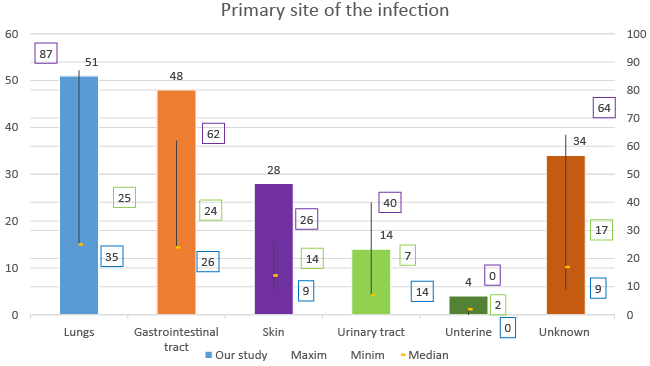 |
| Figure 1: The primary site of the infection in sepsis |
| Diagnosing sepsis using the PCT serum level of = 0.5
ng/ml was most commonly used in the Intensive Care
Unit - 85 patients (47.48%) followed by the Hematology
Department - 27 patients (15.08%) and the Neonatal
Intensive Care Unit - 9 cases (5.02%). |
| Of these cases, 50 patients (27.93%) were diagnosed
with septic shock, 57 (31.84%) with severe sepsis and 72
(40.22%) with sepsis. |
| Analyzing the PCT serum levels as compared to the
other serum markers in patients with sepsis versus patients
without sepsis, we obtained the following data, which are
presented in Table 1. |
| From the initial study group (n=406), 35.18% of
patients had thrombocytopenia (PLT = 150000 /mm3) and
10.18% had thrombocytosis (PLT = 400000/mm3). The
lowest count for PLT that was determined was 0/mm3 and
the highest was 840000/mm3. |
| From the group of patients with sepsis 67 (37.43%)
had thrombocytopenia (PLT = 150000/mm3) and 23 (12.84%) had thrombocytosis (PLT = 400000/mm3). The
lowest value determined was 66/mm3 and the highest was
840000/mm3. 6 patients had platelet counts above 650000/
mm3, three of them being hematological patients. |
| From the patients with thrombocytopenia, 26 had
a serum level of PCT above 2 ng/ml and 20 of them
more than 10 ng/ml. Thrombocytopenia was statistically
correlated with the increased levels of PCT (p=0.037) and
more frequently corresponded to the cases with severe
sepsis or septic shock. For this hypothesis the Pearson?s
r-value was 0.41. There is a positive correlation between
the two variables with a reasonable strength of association
(a moderate uphill, positive, relationship). |
| Decreased platelet counts were associated with serum
levels of PCT = 0.5 ng/ml, a statistically significant
correlation with a p=0.038. There is a weak downhill
(negative) linear relationship with an r-value of -0.25
between the two variables. An OR of 2.09 suggests that
decreased platelets count is associated more frequently
with increasing levels of PCT. An association between the number of erythrocytes (both decreased and increased)
and serum levels of PCT has not been demonstrated in our
study (p=0.09); we have issued this hypothesis because
we noticed that anemia was present in some of the patients
with sepsis. The increased number of leukocytes correlates
statistically with the increasing level of PCT (p=0.00),
which was already known; also for this hypothesis an
OR of 6.99 suggests that leukocytosis is associated with
increased levels of PCT. An r-value of 0.82 suggests that
there is a positive correlation between the two variables
(an increased number of leukocytes and PCT) with a
strong strength of association (a strong uphill, positive,
linear relationship). In our study a decreased number
of white blood cells does not correlate with increased
serum level of PCT (p=0.86). The OR of 1.06 suggests
that leukopenia is more frequent (with 6% more often)
in patients with sepsis. Pairing neutrophilia over 80%
of white blood cells and increased PCT levels correlates
statistically (p=0.00, r-value of 0.80 that suggests a strong
uphill, positive, linear relationship and an OR = 3.03).
Increased erythrocyte sedimentation rate (ESR) is often
associated with the increased levels of PCT (p=0.046),
with an r-value of 0.39 (that suggests a moderate uphill,
positive relationship) and an OR of 2.97. |
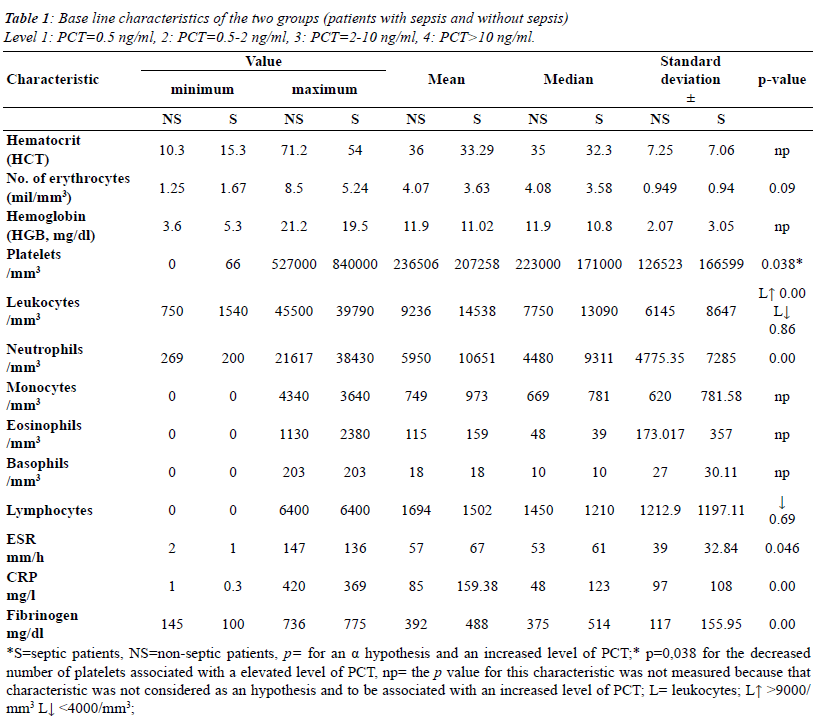 |
| The level of the C-reactive protein and fibrinogen has
also been statistically analyzed; the increase level of PCT
correlates from a statistical point of view with an increased
level of this markers (p=0.00), with an OR of 18.41,
respectively 4.46 and an r-value of 0.80, respectively
0.50. The increase of the CRP and fibrinogen does not
involve the increase of the PCT while the increase of PCT
involves increasing fibrinogen and C-reactive protein.
There is a positive correlation between the increased PCT
level and an increased level of CRP with a strong strength
of association. There is also a correlation between the
increased PCT level and an increased level of fibrinogen
with a moderate uphill (positive) relationship. |
| For the patients with sepsis, the lowest value of
leukocytes was 1540/mm3 and the highest value was
39790/mm3; the neutrophil count ranged between 200/
mm3 and 38430/mm3. |
| The distribution level of CRP, ESR and fibrinogen is
done on a large beach except for a hiatus of values for the
fibrinogen and ESR levels between 110-160. |
| In assessing the severity and the death rate in our study,
we used the APACHE II score. For the patients with serum
PCT levels = 10 ng/ml. APACHE II scores ranged from 18
to 46 points and the possible risk of death between 20.5%-
96.1%. |
| For the patients with serum PCT levels between 2-10
ng/ml, APACHE II score ranged from 15 to 30 points and
the possible risk of death between 21% and 76%. There
are clear differences between the severity of cases and the
risk of death in patients with serum PCT levels = 10 ng/ml
and those with serum PCT levels of 2-10 ng/ml. |
| For the patients with serum PCT levels between 0.5-
2 ng/ml, the APACHE II score ranged from 18 to 26
points and the possible risk of death between 21.2% and
59.7%. Most patients in this group were hospitalized in the
Cardiology ward, their diagnosis requiring determining
the PCT level of infective endocarditis. |
| For the patients with serum PCT levels of 0.5 ng/ml,
APACHE II score ranged between 9 and 21 points and
the possible risk of death was within the range of 9.9%
and 38.9%. Associating with PCT the APACHE II score,
we can say that the serum procalcitonin provides indirect
information about the severity and risk of death of the
patient. |
| Overall, the severity score ranged from 9 to 46 points
and possible risk of death between 9.9% and 96.1% with
an average of 27.5 points (Figure 2). |
| The rate of death recorded in patients with
thrombocytopenia and a PCT level >10 ng/ml was 45%.
Among the patients with thrombocytopenia and a PCT
level above the normal value, the death rate was 23.40%,
accounting for 11 deaths, patients aged over 57 years with
an average age of 66.5 years. |
| The analysis of the clinical parameters on subgroups
highlights no differences in the severity of sepsis, except
in patients with a serum PCT levels over 10 ng/ml, with an
average SOFA score of 8. |
| We also noticed that the serum PCT levels increase with
the severity of sepsis and` with the occurrence of organ
failure that can be used for identifying the patients with
a high risk or a guarded prognosis (Table 2 and APACHE
II score) without being able to improve the death rate in
these cases, as it was also demonstrated in other studies
[6,7]. |
| In addition to the pathology for which the patients were
hospitalized (sepsis, severe sepsis and septic shock), most
patients had a background disorder as well. The Charlson
Comorbidities score, which analyzes the risk of death for
a period of 10 years for the patients with sepsis, showed
values ranging from 1 to 12 points. |
| The estimated death rate was evaluated using the
Kaplan Meier statistical analysis based on the serum levels of procalcitonin, the C-reactive protein serum level,
the age and type of disease of the patients who had been
hospitalized. |
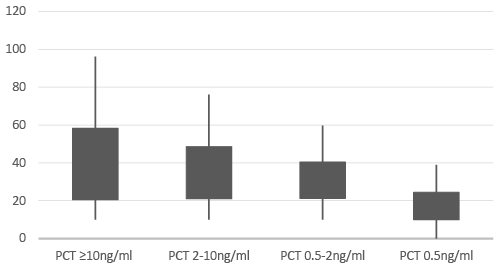 |
| Figure 2: Graphic representation of the APACHE II score
and the PCT level |
 |
| From the total number of patients with sepsis (n=179),
43 patients died (24.02%). |
| There are significant differences between the death rate and the serum levels of procalcitonin (Figure 3), the death
rate for the serum PCT levels of 0.5 ng/ml was 12.19%,
for PCT of 0.5-2 ng/ml it was 10%, for PCT 2-10 ng/ml
it was 44.11% and for PCT >10 ng/ml the death rate was
47.05%. |
| From the total number of patients without sepsis
(n=227), 19 patients died during the hospitalization period, accounting for 8.37%. Overall, from the initial number
of patients enrolled in the study, 62 patients died during
hospitalization, accounting for 15.27% of cases. |
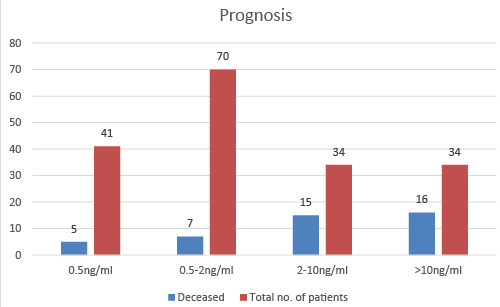 |
| Figure 3: Graphic representation of the prognosis of patients with sepsis according to the PCT serum levels |
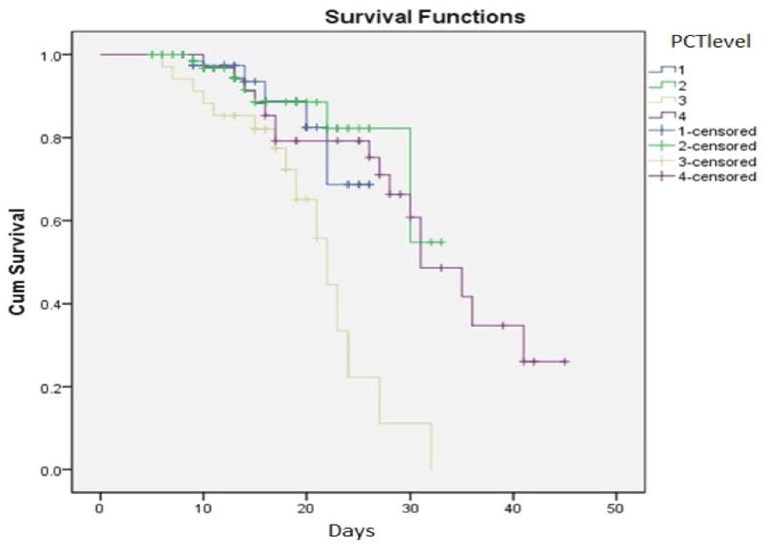 |
Figure 4: The Kaplan-Meier survival rate analysis within 55 days.
And add as a legend: *serum PCT level: 1: PCT 0.5ng/ml, 2: PCT 0.5-2ng/ml, 3: PCT 2-10ng/ml, 4: PCT>10ng/ml |
| The Kaplan-Meier survival analysis, in which the PCT
serum level had been set as an influencing factor, was
used in order to estimate the death rate and this is what it
revealed: for the patients with a PCT level of 0.5 ng/ml, the
estimated survival rate at 30 days was 73%, for the ones
with a PCT level of 0.5-2 ng/ml the analysis estimates a
survival rate of 83% at 30 days and 55% at 35 days; for
patients with PCT levels between 2-10 ng/ml, the survival
rate was 58% at 25 days and for patients with PCT levels
>10 ng/ml, the estimated survival rate at 45 days was 35%.
In our study, as well as in other data found din literature
[8], the PCT demonstrated its importance in identifying
critical patients with higher mortality rate. On the other
hand, there are also studies in which the PCT value does
not correlate with a high risk of mortality [9]. Reducing
the duration of administration of antibiotics by monitoring
PCT is supported by a number of studies [10-17]. |
| We analyzed the receiver operating characteristic curve
(ROC curve) that highlights an area under the curve of
.911 (with a 95% confidence interval [CI] between 0.880
and 0.943); we can say that the determination of serum
procalcitonin is the ?gold standard? for the diagnosis of
patients with sepsis, severe sepsis and septic shock. For a
cutoff point of ~ 0.5 ng/ml the sensitivity of the test is 86%
and the specificity is 91%. |
| Similar data were published in Critical Care by Canan
Balcl (Usefulness of procalcitonin for diagnosis of sepsis
in the Intensive Care Unit) which suggests a sensitivity of
85% and a specificity of 91% [18]. Other meta-analyses
place these values in the neighborhood of 80%. |
Conclusion |
| Measuring the PCT serum level was important in
the diagnosis of fever associated with hematological
malignancies, in cases of sepsis, infective endocarditis
and acute pneumonia. The primary site of infections for
our sepsis cases was the respiratory system followed
by gastrointestinal tract, skin or soft tissue infections
and urinary tract infections. Among the pathogens
Acinetobacter baumannii was most frequently isolated
alone or in assosiation with other pathogens, followed by
Enterococcus spp., Enterobacter spp. and Candida spp.
was responsible for 5.58% of the cases. Higher Serum
levels of PCT were associated with thrombocytopenia,
leukocytosis with neutrophilia, increased CRP and
fibrinogen level. The death rate correlated with the PCT
values above 10 ng/ml and thrombocytopenia, APACHE
II score and with a mean SOFA score of 8. For a cutoff
value of 0.5 ng/ml in our study, the sensitivity of the PCT
was 86% with 91% specificity. Routine determination
of serum procalcitonin levels in sepsis improves patient
management, for example by preventing unexpected use
of ultra-board-spectrum antibiotics and backup antibiotics, well known for multidrug resistant strains selection.
Placing procalcitonin in a key step in the schemes of the
management of patients suspected of sepsis is an important
factor in determining the strategy that should be followed,
the antibacterial and immunological therapy and the
treatment costs implication. Procalcitonin remains so far
the best pro-inflammatory marker used in the management
of patients with severe bacterial infections. |
Conflict of Interest |
| The authors have no conflicts of interest to declare. |
Author Contributions |
| RMB made substantial contribution to conception and
design of the manuscript. RMB also performed the analysis
and interpretation of data. VB was involved in drafting the
manuscript, acquisition of data and interpretation of data.
All authors read and approved the final manuscript. |
Consent Section |
| Written informed consent was obtained from the patients
on their admission to the hospital when their consent was
requested for all their laboratory investigations that would
be performed. The study was accepted by the Ethics
Committee of the hospital and also by the University, the
study is part of RMB bachelor`s degree thesis, and they
encourage publishing the article. No other additional
consent was required for the study as this was prospective
observational one. |
References |
- Dellinger RP, Levy MM, Rhodes A, Annane D, Gerlach H, Opal SM. Surviving Sepsis Campaign: International
- Guidelines for Management of Severe Sepsis and Septic Shock: 2012. Crit Care Med 2013; 41: 580-637.
- Brun-Buisson C, Doyon F, Carlet J, Dellamonica P, Guion F, Lepoutre A. Incidence, risk factors, and outcome of severe sepsis and septic shock in adults. A multicenter prospective study in intensive care units. French ICU Group for Severe Sepsis. JAMA 1995; 274: 968-974.
- Bernard GR, Wheeler AP, Russell JA, Schein R, Summer WR, Steinberg KP. The effects of ibuprofen on the physiology and survival of patients with sepsis. The Ibuprofen in Sepsis Study Group. N Engl J Med 1997; 336: 912-918.
- Angus DC, Birmingham MC, Balk RA, Scannon PJ, Collins D, Krause JA. E5 murine monoclonal antiendotoxin antibody in gram-negative sepsis: a randomized controlled trial. E5 Study Investigators. JAMA 2000; 283: 1723-1730.
- Fisher CJ Jr, Dhainaut JF, Opal SM, Pribble JP, Balk RA, Slotman GJ. Recombinant human interleukin 1 receptor antagonist in the treatment of patients with sepsis syndrome. Results from a randomized, double-blind, placebo-controlled trial. Phase III rhIL-1ra Sepsis Syndrome Study Group. JAMA 1994; 271: 1836-1843.
- Jensen JU, Hein L, Lundgren B, Bestle MH, Mohr TT, Andersen MH. Procalcitonin-guided interventions against infections to increase early appropriate antibiotics and improve survival in the intensive care unit: a randomized trial. Crit Care Med 2011; 39: 2048-2058.
- Jensen JU, Lundgren B, Hein L, Mohr T, Petersen PL, Sndresen LH. The Procalcitonin And Survival Study (PASS) - a randomised multi-center investigator-initiated trial to investigate whether daily measurements biomarker Procalcitonin and pro-active diagnostic and therapeutic responses to abnormal Procalcitonin levels, can improve survival in intensive care unit patients. Calculated sample size (target population): 1000 patients. BMC Infect Dis 2008; 8: 91.
- Jensen JU, Heslet L, Jensen TH, Espersen K, Steffensen P, Tvede M. Procalcitonin increase in early identification of critically ill patients at high risk of mortality. Crit Care Med 2006; 34: 2596-2602.
- Prkno A, Wacker C, Brunkhorst FM, Schlattmann P. Procalcitonin-guided therapy in intensive care unit patients with severe sepsis and septic shock--a systematic review and meta-analysis. Crit Care 2013; 17: R291.
- Shehabi Y, Sterba M, Garrett PM, Rachakonda KS, Stephens D, Harrigan P. Procalcitonin algorithm in critically ill adults with undifferentiated infection or suspected sepsis. A randomized controlled trial. Am J Respir Crit Care Med 2014; 190: 1102-1110.
- Hohn A, Schroeder S, Gehrt A, Bernhardt K, Bein B, Wegscheider K. Procalcitonin-guided algorithm to reduce length of antibiotic therapy in patients with severe sepsis and septic shock. BMC Infect Dis 2013; 13: 158.
- Assink-de Jong E, de Lange DW, van Oers JA, Nijsten MW, Twisk JW, Beishuizen A. Stop Antibiotics on guidance of Procalcitonin Study (SAPS): a randomised prospective multicenter investigator-initiated trial to analyse whether daily measurements of procalcitonin versus a standard-of-care approach can safely shorten antibiotic duration. BMC Infect Dis 2013; 13: 178.
- Kollef MH. Will procalcitonin reduce antibiotic use in intensive care? The Lancet 2010; 375: 435-436.
- Kopterides P, Siempos II, Tsangaris I, Tsantes A, Armanganidis A. Procalcitonin-guided algorithms of antibiotic therapy in the intensive care unit: a systematic review and meta-analysis of randomized controlled trials. Crit Care Med 2010; 38: 2229-2241.
- Heyland DK, Johnson AP, Reynolds SC, Muscedere J. Procalcitonin for reduced antibiotic exposure in the critical care setting: a systematic review and an economic evaluation. Crit Care Med 2011; 39: 1792-1799.
- Schuetz P, Chiappa V, Briel M, Greenwald JL. Procalcitonin algorithms for antibiotic therapy decisions: a systematic review of randomized controlled trials and recommendations for clinical algorithms. Arch Intern Med 2011; 171: 1322- 1331.
- Bouadma L, Luyt CE, Tubach F, Cracco C, Alvarez A, Schwebel C, et al. Use of procalcitonin to reduce patients' exposure to antibiotics in intensive care units (PRORATA trial): a multicentre randomised controlled trial. Lancet 2010; 375: 463-474.
- Balcl C, Sungurtekin H, Gurses E, Sungurtekin U, Kaptanogul B. Usefulness of procalcitonin for diagnosis of sepsis in the intensive care unit. Crit Care 2003; 7: 85-90.
|





